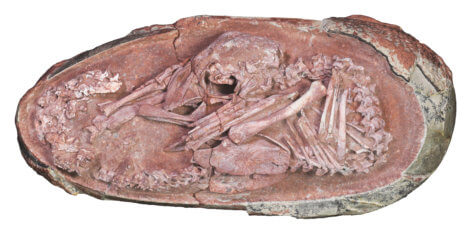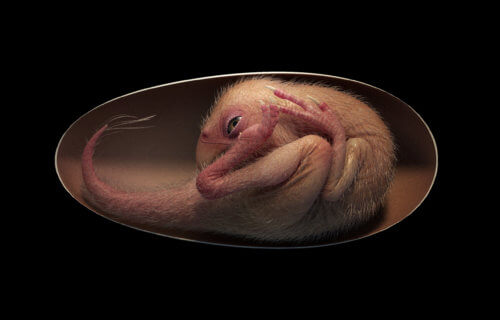BIRMINGHAM, United Kingdom — Scientists have discovered a fossilized egg containing the world’s most complete baby dinosaur. The exquisitely preserved embryo was lying in a bird-like posture just before hatching.
Unfortunately, an international team of researchers says it died about 70 million years ago, before having a chance to hatch. The head is tucked below the body with the feet on either side. Its back is curled along the blunt end of the shell. Researchers believed this posture, which boosts survival rates, was unique to modern birds.
The discovery adds to evidence our feathered friends really are the descendants of dinosaurs.
“Most known non-avian dinosaur embryos are incomplete with skeletons disarticulated,” says first author Fion Waisum Ma, a PhD student at the University of Birmingham, in a media release.
“We were surprised to see this embryo beautifully preserved inside a dinosaur egg, lying in a bird-like posture. This posture had not been recognized in non-avian dinosaurs before.”

The origin of modern-day baby birds?
Researchers found the egg at the Upper Cretaceous Nanxiong Formation near the Ganzhou railway station in Jiangxi Province, southern China. They’re calling the fossil “Baby Yingliang,” noting that the unborn dinosaur was a member of the oviraptorosaurs. These dinosaurs were beaked, feathered, and toothless theropods that thrived during the Cretaceous Period.
The “exceedingly rare” embryo suggests this species may have pioneered the modern-day birth pose. The study also reveals a possible link between modern birds and dinosaurs.
The baby is lying in its life position without much disruption from fossilization. Estimates reveal the baby is almost a foot long from head to tail but remains curled up inside the seven-inch-long egg.

Ma adds that the egg may help answer a lot of questions about dinosaur growth and reproduction.
“It is interesting to see this dinosaur embryo and a chicken embryo pose in a similar way inside the egg, which possibly indicates similar prehatching behaviors,” Ma says in a university release.
Scientists were able to identify “Baby Yingliang” as an oviraptorosaur thanks to its deep, toothless skull. Oviraptorosaurs are closely related to today’s birds and their remains have been discovered across Asia and North America.
Variable beak shapes and body sizes mean some likely adopted plant-based diets, while others were omnivores and carnivores. Birds develop a series of tucking postures in which they bend their body and bring their head under their wing soon before hatching. Embryos that fail to attain such positions have a higher chance of death due to unsuccessful hatching.
Baby Yingliang ‘is one of the most beautiful fossils’
The international team compared “Baby Yingliang” with the embryos of other theropods, long-necked sauropod dinosaurs and birds. They believe the tucking posture first evolved in theropods — a dinosaur family which also includes the T-Rex.
The dinosaur embryo was acquired by the director of Yingliang Group in 2000, Liang Liu, who suspected that the fossil may contain an egg. During the construction of Yingliang Stone Nature History Museum in 2010s, museum staff sorted through the collection and discovered the specimens.
“Museum staff identified them as dinosaur eggs and saw some bones on the broken cross section of one of the eggs,” says Lida Xing of China University of Geosciences.
“Skeletons of dinosaurs are rarely preserved in ovo, but these embryonic fossils are important records of dinosaur reproduction as an embryo documents stages of early growth and development up until hatching,” researchers write in the journal iScience.
The researchers plan to continue studying the dinosaur in even more depth. They will scan its internal anatomy including the skull bones and other body parts that are still covered in rocks.
“This dinosaur embryo inside its egg is one of the most beautiful fossils I have ever seen,” study co-author Prof. Steve Brusatte from the University of Edinburgh concludes. “This little prenatal dinosaur looks just like a baby bird curled in its egg, which is yet more evidence that many features characteristic of today’s birds first evolved in their dinosaur ancestors.”
Currently, the egg resides in the Yingliang Stone Nature History Museum in the coastal city of Xiamen.
South West News Service writer Mark Waghorn contributed to this report.
